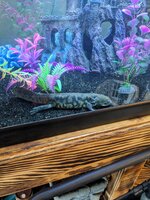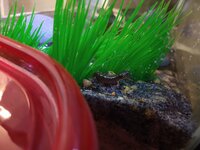LauraOlson92
New member
Hello, I've had my Mudpuppy for 1 week. Previous to getting her we had recently moved, so our 150 gallon tank has only been set up for 3 weeks and had been treated with Quick Start and Prime water softener. We have a bristle nosed pleco, an angelfish and a few emperor tetras, none of our fish seem to be having problems. However, the last few days we have noticed our Mudpuppy getting white bumps all over her body. I'm really concerned and don't know how to handle this situation. Her water is typically always sitting at 70 degrees. The pH seems to be sitting at 7.6 which is high right? What do I do, should I be really worried? She is pretty decently active from what I can tell. Here is an attached picture of how she looks today. You may have to zoom in.


